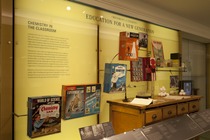Chemistry set
 |
|
|
|
|
|
|
A chemistry set is an educational toy allowing the user (typically a teenager) to perform simple chemistry experiments.
The earliest forerunners of the chemistry set are 17th century books on "natural magick", "which all excellent wise men do admit and embrace, and worship with great applause; neither is there any thing more highly esteemed, or better thought of, by men of learning." Authors such as Giambattista della Porta included chemical magic tricks and scientific puzzles along with more serious topics.
The earliest chemistry sets were developed in the 18th century in England and Germany, with the purpose of teaching chemistry to adults. In 1791, Description of a portable chest of chemistry : or, Complete collection of chemical tests for the use of chemists, physicians, mineralogists, metallurgists, scientific artists, manufacturers, farmers, and the cultivators of natural philosophy by Johann Friedrich August Göttling, translated from German, was published in English.Friedrich Accum of London, England also sold portable chemistry sets and materials to refill them. Used primarily for training druggists and medical students, they could also be carried and used in the field.
Scientific kits also attracted well-educated members of the upper class who enjoyed experimenting and demonstrating their results.James Woodhouse of Philadelphia presented a Young Chemist's Pocket Companion (1797) with an accompanying portable laboratory, specifically targeted ladies and gentlemen. Jane Marcet's books on chemistry helped to popularize chemistry as a well-to-do pastime for both men and women.
Beginning in the late 1850s John J. Griffin & Sons sold a line of "chemical cabinets", eventually offering 11 categories. These were marketed primarily to adults including elementary school teachers as well as students at the Royal Naval College, the Royal Agricultural Society, and the universities of Oxford and Cambridge.
...
Wikipedia
